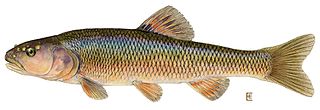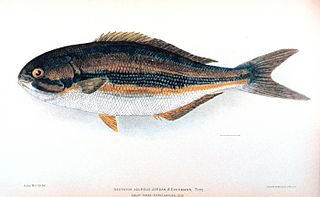A dace is a small fish that can be one of many different species. The unmodified name is usually a reference to the common dace. This, like most fishes called "daces", belongs to the family Cyprinidae, mostly in subfamily Leuciscinae.

The Eurasian minnow, minnow, or common minnow is a small species of freshwater fish in the carp family Cyprinidae. It is the type species of genus Phoxinus. It is ubiquitous throughout much of Eurasia, from Britain and Spain to eastern Siberia, predominantly in cool streams and well-oxygenated lakes and ponds. It is noted for being a gregarious species, shoaling in large numbers.

Phoxinus is a genus of freshwater fish in the family Leuciscidae of order Cypriniformes, and the only members of the subfamily Phoxininae, or Eurasian minnows. The type species is Phoxinus phoxinus. The other species in this genus are also commonly known as minnows. The name "minnow" was what early English fisherman used to describe "small and insignificant". The genus Phoxinus is found throughout Eurasia, and includes 21 known species. Previously, members of the North American genus Chrosomus were also believed to form part of this genus.

The fallfish is a North American freshwater fish, a chub in the family Cyprinidae. The fallfish is the largest minnow species native to Eastern North America.

The minnow-nase, Serbo-Croatian: podbila, is a species of freshwater fish in the family Cyprinidae. It is found in Bosnia and Herzegovina and Croatia. Its natural habitats are rivers, intermittent rivers, and inland karsts. It is threatened by habitat loss and considered Endangered (EN).

The blackside dace ) is a species of ray-finned fish in the family Cyprinidae. It is endemic to the Cumberland River drainage in Kentucky and Tennessee as well as the Powell River drainage in Virginia in the United States. It is a federally listed threatened species.
The Tennessee dace is a species of ray-finned fish in the family Cyprinidae. It is found only in the United States; particularly in northeast Tennessee and southwest Virginia, and parts of extreme northwest Georgia. Until recently, they were considered a subspecies of mountain redbelly dace. They are commonly found in East Tennessee in spring fed first-order streams, often in silt and fine gravel pools, or undercut banks. These streams usually do not exceed two meters in width.
The Sandhills chub is a species of freshwater fish in the family Cyprinidae of order Cypriniformes. There are 4 species of Semotilus, 2 of which occur in South Carolina. This fish is found only in North Carolina and South Carolina. The Sandhills chub is predominately found in the Carolina Sandhills and some areas of Cape Fear, Pee Dee and Santee river drainages. It is characterized by its robust body, large head and lack of a dark blotch or smudge on their dorsal fin which is present on the closely related Creek Chub. The Sandhills chub has fine scales, a pinkish body and can be up to 9.4 inches.

Semotilus is the genus of creek chubs, ray-finned fish in the family Cyprinidae. The term "creek chub" is sometimes used for individual species, particularly the common creek chub, S. atromaculatus. The creek chub species of minnows can grow from 6 to 10 inches and resemble the grass carp. They can be found in the United States and Canada in any small stream or creek. They hide under small rocks for protection. They have a small black spot on the dorsal fin for easy identification.

Chub is a common fish name. It pertains to any one of a number of ray-finned fish in several families and genera. In the UK, the term chub usually refers to the species Squalius cephalus. In addition, see sea chub.

Semotilus atromaculatus, known as the creek chub or the common creek chub, is a small minnow, a freshwater fish found in the eastern US and Canada. Differing in size and color depending on origin of development, the creek chub can usually be defined by a dark brown body with a black lateral line spanning horizontally across the body. It lives primarily within streams and rivers. Creek Chubs attain lengths of 2-6 inches with larger specimens of up to 12 inches possible. The genus name Semotilus derives from the Greek word sema, and atromaculatus comes from the Latin word "black spots".

Phoxinus apollonicus is a species of small cyprinid fish from Montenegro and Albania.
The Dixie chub is a species of freshwater ray-finned fish from the carp and minnow family Cyprinidae. It is endemic to southeastern United States.

Phoxinus kumgangensis is a species of freshwater fish in the family Cyprinidae. It is endemic to the Korean peninsula.
Phoxinus steindachneri is a species of freshwater fish in the family Cyprinidae. It is found in northeastern Asia.
The Bulgarian minnow is a species of freshwater fish in the family Cyprinidae. It is found in the Veleka and Resowska drainages in Bulgaria and Turkey.
Phoxinus tchangi is a species of freshwater fish in the family Cyprinidae. It is endemic to China and Mongolia.

The Leuciscidae, commonly known as true minnows, are a large family of the freshwater fish order Cypriniformes.









